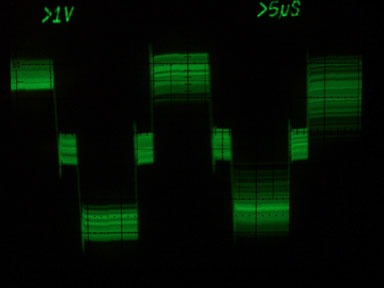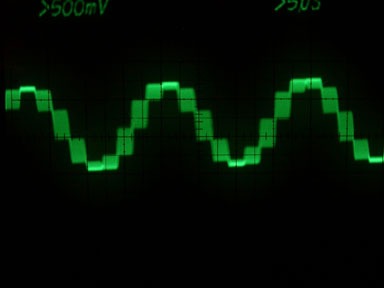That's correct.
Even though it looks hideous, theoretically* your 20KHz sine wave is perfectly represented at a 44.1KHz sampling rate.
*neglecting 16-bit quantization noise, zero-order-hold attenuation, system noise/distortion, assuming a perfect reconstruction filter to eliminate images, etc.
Even though it looks hideous, theoretically* your 20KHz sine wave is perfectly represented at a 44.1KHz sampling rate.
*neglecting 16-bit quantization noise, zero-order-hold attenuation, system noise/distortion, assuming a perfect reconstruction filter to eliminate images, etc.
Re: 44kHz samling freq. gives 1 sample per halfwave for 20kHz sine ?
You still have 16 bit resolution, but only 1 sample (with 16 bit resolution) for every half wave.
\Jens
Bernhard said:So resolution at 20kHz is only one bit out of 16bits for each halfwave ?
You still have 16 bit resolution, but only 1 sample (with 16 bit resolution) for every half wave.
\Jens
Re: Re: 44kHz samling freq. gives 1 sample per halfwave for 20kHz sine ?
Indeed, in fact you should look at it as 2 samples each 16 bit for a 20kHz wave. The reconstruction filter, which is an integral part of the D-A conversion process, will make sure you get a nice sine wave. That is the background behind the Nuiquist criterium: to reconstruct a given freq you need at least 2 samples to nail down the level and phase, so you can convert frequencies up to half the sample rate.
Jan Didden
JensRasmussen said:
You still have 16 bit resolution, but only 1 sample (with 16 bit resolution) for every half wave.
\Jens
Indeed, in fact you should look at it as 2 samples each 16 bit for a 20kHz wave. The reconstruction filter, which is an integral part of the D-A conversion process, will make sure you get a nice sine wave. That is the background behind the Nuiquist criterium: to reconstruct a given freq you need at least 2 samples to nail down the level and phase, so you can convert frequencies up to half the sample rate.
Jan Didden
I don't like it either, You can analyze frequency content from real data, but the reverse is not totally possible. DVD audio and some newer stuff are going to higher sample rates. I spersonnaly like 10 samples per sine wave, but there might be some other theory indicating that possible increasing the number of bits provide more significant improvements.
soongsc said:I don't like it either, You can analyze frequency content from real data, but the reverse is not totally possible. DVD audio and some newer stuff are going to higher sample rates. I spersonnaly like 10 samples per sine wave, but there might be some other theory indicating that possible increasing the number of bits provide more significant improvements.
Well, 44.1 or 192kHz gives the same reconstitued sine at 20kHz from 2 samples or 6 samples or what have you. The difference lies in the noise spectrum. The higher you sample, the higher the noise turns up in freq, so the easier it is to filter out. At 44.1 kHz you would need a brick wall filter at 22kHz to get rid of all the noise, and brick wall filters don't exist in analog. They do now, of course, in DSP implementations. So, there are different issues, that are related, but not interchangeable.
But, how counterintuitive it feels, 2 samples will nail ANY wave, provided you take care of the postfiltering.
Jan Didden
If you are trying to reconstruct a simple sine wave, I suppose 2 samples will do as long as you don't care about any phase shift, because there is no way to determine where in the sine wave the sample took place. Thus you might come up with a smaller amplitude sine wave with a phase shift.
By the way, I am referring to sampling the analog real world signal, not just oversampling existing digital data.
By the way, I am referring to sampling the analog real world signal, not just oversampling existing digital data.
Um, no. You have very good phase resolution. In fact if you have a full height (i.e. +32,767 to -32,768) sine wave at 20kHz you have a phase resolution of well under 1/100th of a degree. At lower amplitudes it drops proportionally. Only at an amplitude of the LSB do you lose most of your phase resolution. Think about the amount of information in the stream.
Originally posted by Francis_Vaughan
Um, no. You have very good phase resolution. In fact if you have a full height (i.e. +32,767 to -32,768) sine wave at 20kHz you have a phase resolution of well under 1/100th of a degree. At lower amplitudes it drops proportionally. Only at an amplitude of the LSB do you lose most of your phase resolution. Think about the amount of information in the stream.
Let me try and understand this. You have an analog signal at 20K that you sample at 44.1 Hz 16 bits. You can only use one cycle to determine the exact shape of the original wave because the next cycle is a different part of music. Since there is no way to determine whether you sampled the peaks or other locations.. Oh! I see! the difference amplitude in the two samples help you determine the lowest frequency possible, so the theory works.
Now since you only have 16 bits, you really need higer bit resolution or some sort of analog filter to smooth the discrete data into continuous wave. I wonder if sound cards do this kind of processing or not, or whether it's done in the software.
Originally posted by soongsc [snip]Now since you only have 16 bits, you really need higer bit resolution or some sort of analog filter to smooth the discrete data into continuous wave. I wonder if sound cards do this kind of processing or not, or whether it's done in the software. [/B]
That is why the post-DAC filtering is AN INTEGRAL PART of the conversion process. It only works as advertised if you include the filtering.
Jan Didden
Bernhard said:So how good work the mostly unfiltered TDA1543 non-os dac ?
I don't know exactly what the 'mostly unfiltered' DAC is, but if you skimp on the filter, you get the noise in the upper spectrum in your signal, the familiar staircase components.
Perceptually, if you are not experienced in recognising it, you will get the impression that your system is bright, clear and analytical. But, that's the perceptional side of it.
Jan Didden
Bernhard said:If you have 2 samples @ 20kHz you have 20 samples @ 2 kHz and you already can see the stairs on a scope.
Oh yes, that is also the reason why it is so difficult to find a good opamp for an I/V converter. That opamp has, in theory, to respond to those staircase steps with the risetime of that signal. Not easy.
Jan didden
Bernhard said:And my speaker 100kHz
Speakers???? You actually listen!!!!!! I'm so stunned you could knock me over with a feather.
- Status
- This old topic is closed. If you want to reopen this topic, contact a moderator using the "Report Post" button.
- Home
- Source & Line
- Digital Source
- 44kHz sampling freq. gives 1 sample per halfwave for 20kHz sine ?

